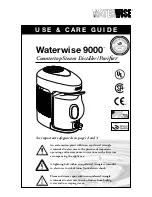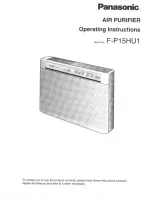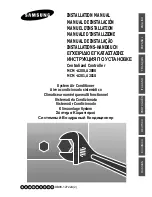
Left or left-rear piping
Note:
Be sure to reattach the drain
hose and the drain cap in case
of left or left-rear piping.
Otherwise, it could cause drops
of water to drip down from the
drain hose.
1) Put the refrigerant piping and the drain hose together,
then firmly apply felt tape (7) from the end.
Felt tape (7) overlap width should be 1/3 the tape width.
Use a bandage stopper at the end of felt tape (7).
2) Pull out the drain cap at the rear right of the indoor unit.
(Fig. 1)
• Hold the convex section at the end and pull the drain
cap.
3) Pull out the drain hose at the rear left of the indoor unit.
(Fig. 2)
• Hold the claw marked by the arrows and pull out the
drain hose forward.
4) Put the drain cap into the section to which the drain
hose is to be attached at the rear of the indoor unit.
(Fig. 3)
• Insert not sharp-edged tools such as screwdrivers into
the hole at the end of the cap and insert the cap fully
into the drain pan.
5) Insert the drain hose fully into the drain pan at the rear
right of the indoor unit. (Fig. 4)
• Check if the hose is hooked securely to the projection
of its inserting part at the drain pan.
6) Insert the drain hose into wall hole sleeve (C), and hook
the upper part of indoor unit on installation plate (1). Then,
move the indoor unit completely to the left in order to make
placing the piping in the back space of the unit easier.
7) Cut out a piece of cardboard from the shipping box, roll
it up, hook it onto the back rib, and use it as a spacer to
lift the indoor unit. (Fig. 5)
8) Connect the refrigerant piping with the extension pipe
(B).
9) Thrust the lower part of the indoor unit into the installation
plate (1).
3-2. FLARING WORK
1) Cut the copper pipe correctly with pipe cutter.
(Fig. 1, 2)
2) Completely remove all burrs from the cut cross section
of pipe. (Fig. 3)
• Put the end of the copper pipe to downward direction
as you remove burrs in order to avoid to let burrs
drop in the piping.
3) Remove flare nuts attached to indoor and outdoor
units, then put them on pipe having completed burr
removal. (Not possible to put them on after flaring
work.)
4) Flaring work (Fig. 4, 5). Firmly hold copper pipe in the
dimension shown in the table. Select A mm from the
table according to the tool you use.
5) Check
• Compare the flared work with Fig. 6.
• If flare is noted to be defective, cut off the flared sec-
tion and do flaring work again.
3-3. PIPE CONNECTION
• Fasten flare nut with a torque wrench as specified in the table.
• When fastened too tight, flare nut may break after a long period and cause refrigerant leak-
age.
• Be sure to wrap insulation around the piping. Direct contact with the bare piping may result
in burns or frostbite.
Indoor unit connection
Connect both liquid and gas pipings to indoor unit.
• Apply a thin coat of refrigeration oil (J) on the seat surface of pipe.
• For connection, first align the center, then tighten the first 3 to 4 turns of flare nut.
• Use tightening torque table above as a guideline for indoor unit side union joint section, and
tighten using two wrenches. Excessive tightening damages the flare section.
Outdoor unit connection
Connect pipes to stop valve pipe joint of the outdoor unit in the
same manner applied for indoor unit.
• For tightening, use a torque wrench or spanner and use the
same tightening torque applied for indoor unit.
3-4. INSULATION AND TAPING
1) Cover piping joints with pipe cover.
2) For outdoor unit side, surely insulate every piping including valves.
3) Using piping tape (G), apply taping starting from the entry of outdoor unit.
• Stop the end of piping tape (G) with tape (with adhesive agent attached).
• When piping have to be arranged through above ceiling, closet or where the temperature
and humidity are high, wind additional commercially sold insulation to prevent condensa-
tion.
Rear, right, or downward piping
1) Put the refrigerant piping and the drain hose
together, then firmly apply piping tape (G) from
the end.
2) Insert the piping and the drain hose into the wall
hole sleeve (C), and hook the upper part of the
indoor unit on the installation plate (1).
3) Check if the indoor unit is hooked securely on the installation plate (1) by moving
the unit to left and right.
4) Thrust the lower part of the indoor unit into the installation plate (1).
Drain Piping
• If the extension drain hose has to pass through a room, be sure to wrap it with com-
mercially sold insulation.
• The drain hose should point downward for easy drain flow. (Fig. 1)
• If the drain hose provided with the indoor unit is too short, connect it with drain hose
(I) that should be provided at your site. (Fig. 2)
• When connecting the drain hose to the hard vinyl chloride pipe, be sure to insert it
securely into the pipe. (Fig. 3)
Do not make drain piping as shown below.
Do not raise
Accumulated
drain water
Air
Waving
Water
leakage
Water
leakage
Water
leakage
Tip of drain
hose dipped
in water
Ditch
At least
50 mm
gap
Cut off in case of
right piping.
Cut off in case of down-
ward piping.
Copper
pipe
Good
90°
Tilted Uneven Burred
No good
Fig. 1
Fig. 2
Burr
Copper pipe
Spare reamer
Pipe cutter
Clutch type
Flaring tool
Fig. 4
Fig. 3
Downward
slope
Drain
hose
Soft hose
I.D. 15 mm
Drain hose
Hard vinyl chloride
pipe I.D. 30 mm
Insert
securely
Different
diameter
joint
70 cm or
more
Fig. 1
Fig. 2
Fig. 3
Drain cap
Drain cap
Drain hose
Cut off in case of left
piping.
Drain cap
Piping tape (G)
Drain hose
Fig. 1
Fig. 2
Fig. 3
Fig. 4
Fig. 5
Felt tape (7)
3. OUTDOOR UNIT INSTALLATION
Smooth all
around
Even length
all around
Inside is shin-
ing without any
scratches.
A
Flare nut
Die
Fig. 5
Fig. 6
Copper pipe
Wing nut type
3-1. CONNECTING WIRES FOR OUTDOOR UNIT
1) Open the service panel.
2) Loosen terminal screw, and connect indoor/outdoor unit connecting wire (A) from
the indoor unit correctly on the terminal block. Be careful not to make mis-wiring. Fix
the wire to the terminal block securely so that no part of its core is appeared, and no
external force is conveyed to the connecting section of the terminal block.
3) Firmly tighten the terminal screws to prevent them from loosening. After tightening,
pull the wires lightly to confirm that they do not move.
4) Connect power supply cord (K).
5) Fix indoor/outdoor unit connecting wire (A) and power supply cord (K) with the cord clamp.
6) Close the service panel securely.
Terminal block
Cord clamp
L N
Power supply cord (K)
Indoor/outdoor unit
connecting wire (A)
• Make earth wire a little longer than
others. (More than 100 mm)
• For future servicing, give extra
length to the connecting wires.
• Be sure to attach each screw to
its correspondent terminal when
securing the cord and/or the wire
to the terminal block.
15 mm
35 mm
Lead wire
Pipe diameter
(mm)
Nut
(mm)
A (mm)
Tightening torque
Clutch type
tool
for R410A
Clutch type
tool
for R22
Wing nut
type tool
for R22
N•m
kgf•cm
ø6.35 (1/4”)
17
0 to 0.5
1.0 to 1.5
1.5 to 2.0
13.7 to 17.7 140 to 180
ø9.52 (3/8”)
22
34.3 to 41.2 350 to 420
ø12.7 (1/2”)
26
2.0 to 2.5
49.0 to 56.4 500 to 575
ø15.88 (5/8”)
29
73.5 to 78.4 750 to 800
WARNING
When installing the unit, securely connect the refrigerant
pipes before starting the compressor.






















